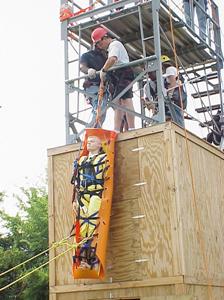 |
|||||||||||||||||||
General Summary of Training ActivitiesWorker Education and Training ProgramBackgroundThe Superfund Amendments and Reauthorization Act (SARA) of 1986 (http://www.epa.gov/region5/defs/html/sara.htm) 
During the past eighteen years, the NIEHS WETP in conjunction with 20 awardees has
supported the development of curricula and initiation of training programs throughout
the country to help employers meet Occupational Safety and Health Administration
(OSHA) requirements under CFR 1910.120, Hazardous Waste Operations & Emergency
Response (http://www.osha.gov/pls/oshaweb/owadisp.show_ document?p_table=STANDARDS&p_id=9765) The training in the program meets the minimum requirements of the OSHA 29 CFR
1910.120 and EPA 40 CFR 311 (http://hazmat.dot.gov/regs/49cfr/172/172.704. htm) Since 1986, a number of other training grant programs have been authorized and funded by Congress. These programs include workers involved in transporting hazardous materials, a minority worker job training program (MWTP) to serve urban youth, an initiative focused on job training for brownfields cleanup sites (BMWTP), a program that will train workers in prevention and response techniques related to future terrorist incidents (HDPTP), and a program targeted to workers involved in the cleanup of the DOE nuclear weapons facilities. The Brownfields and the DOE training programs continue to be funded through Interagency Agreements with EPA and DOE. Direct appropriation to the NIEHS for the HWWTP allowed the WETP to take a percentage of the funding to establish a Small Business Innovative Research (SBIR)/ Small Business Technology Transfer Research (STTR) program that focuses on developing E- Learning health and safety products. In 2001, the WETP also received significant supplemental funding for its awardees in response to the September 11th attacks and subsequent emergency response and remediation activities. These supplemental awards include grant activities relating to training workers to undertake cleanup of environmental problems stemming from Bioterrorism (Anthrax), World Trade Center (WTC), and potential Weapons of Mass Destruction incidents (WMD). Program AreasDuring 2004, the NIEHS released a program announcement for the WETP requesting applications to support training activities over the next five-year period (FY 2005-2010). The Request for Applications (RFA) included four distinct program areas: the Hazardous Waste Worker Training Program (HWWTP), the Minority Worker Training Program (MWTP), the Brownfields Minority Worker Training Program (BMWTP), and the Hazmat Disaster Preparedness Program (HDPTP) and a distinct component for the DOE Nuclear Weapons Complex (DOE Program). After a lengthy review by committees of outside experts and other federal agencies, in a resulting competition, NIEHS announced 17 awards in September 2005 with over 80 participating institutions in this program. NIEHS awarded 17 awards for the HWWTP, 4 awards for the MWTP, 4 awards for the EPA BMWTP, 9 awards for the HDPTP, and 8 awards for DOE Nuclear Worker Training Program. As a result of this competition, the NIEHS WETP supports the development of model worker safety and health training development and delivery in five areas:
Funding SummaryThrough direct appropriation to the NIEHS and interagency agreements with EPA and DOE for budget period September 1, 2005 through August 31, 2006, funds were allocated to continue support of the Worker Education and Training Program (WETP) to train hazardous waste workers and emergency responders. In FY 2005, NIEHS received more than $37 million to support the WETP. Of the $37 million, $26 million from the NIEHS appropriation supported 3 programs which included $20,541,460 for the HWWTP, $3,500,000 for the MWTP, and $2,498,208 for the HDPTP. Two million dollars of the FY 2005 EPA interagency agreements funds were allocated to continue support for the BMWTP. In addition, $9,405,846 of the FY 2005 DOE interagency agreements funds was allocated to continue support for the DOE program. As a result, NIEHS awarded:
In a separate action, NIEHS awarded a contract for $863,143 to manage the National Clearinghouse for Worker Safety and Health Training to MDB, Inc. The National Clearinghouse is the national source for hazardous waste worker curricula, technical reports, and weekly news. MDB, Inc. is a privately-owned communications and research consulting company with offices in Washington, DC and Research Triangle Park, NC. More information on the National Clearinghouse can be found on the internet at http://tools.niehs.nih.gov/wetp/ (http://tools.niehs.nih.gov/wetp/) or call 202-331-7733. In addition, under the Small Business Innovation Research (SBIR) and Small Business Technology Transfer (STTR) Program, NIEHS recently made five SBIR awards. These awards were for the development of innovative e-learning products for worker safety and health training. These awards total $592,401. |
|||||||||||||||||||

